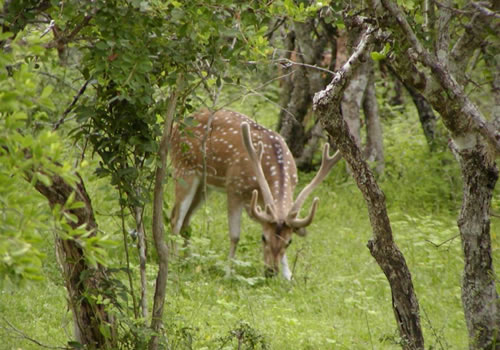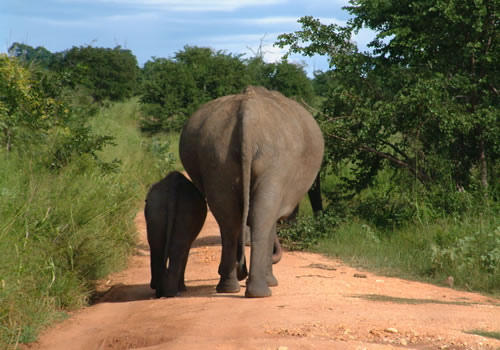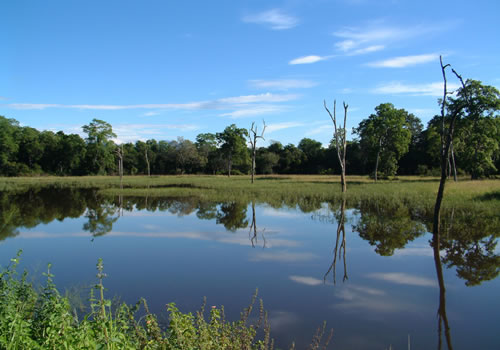Uda Walwe National Park, Sri Lanka is the best place in Asia to see herds of Asian Elephants, the pachyderms in the wild. Uda Walawe National Park, that retains their leaves even during the dry season, is one of Sri Lanka's Dry-Zone Dry Evergreen Forests that harbours one of Asia'a largest & most viable Asian elephant (Elephas maximus) populations. The 30,821ha park was set up in the year 1972 to protect the catchment area of the man-made Rainwater Reservoir located at the south end of the River Walwe. At the same time the reserve was designated to provide sanctuary to wild elephants.
For a dry zone park, it couldn't have been located in a better setting: to the north is grand escarpment of Central Highlands of Sri Lanka; to the south is Walawe ganga river flowing all the way down to the sea at Ambalantota close to Hambantota in the southern coast of Sri Lanka.
Most of all, at the centre of the sanctuary lies the huge man-made rainwater reservoir with a surface area of 3400ha providing irrigation for farmlands downstream & generating hydroelectric power to the tropical island of Sri Lanka. You will be reaching the park by following the road along the 4km bund across the Uda Walawe rainwater reservoir.
The variety of terrain makes the habitat home to variety of wildlife. While woodland of old Teak tree lines the River Walawe, open grassland is traversed by streams & scrub jungle. The extensive area of grassland devoid of forest cover makes the viewing of elephants easier than anywhere else in Asia: herds up to 100 or even more could be seen along the river & near the numerous streams & tanks. Behold the sight & a site of Sri Lanka Holidays. The wild elephants could be seen crossing the River Walawe too. The elephant-proof fence around the perimeter of the park prevents some 600 elephants, roaming freely around the reserve from getting out of it to attack the surrounding farmland. The fence also prevents the cattle, belonging to the farmers of surrounding villages, from getting into the reserve.
Uda Walawe Elephant Transit Centre
In 1995, Department of Wildlife in Sri Lanka, in an attempt to support the orphaned calves from the other areas of the island, set up the Elephant Transit Centre at Uda Walawe National Park itself with the support of Born Free Foundation. Twenty of the 32 calves are "foster parented". As in the famous Pinnawela Elephant Orphanage, herein too you would have the joy of seeing the baby elephants being bottle fed. Although it is fun to watch baby elephants being bottle-fed every three hours, since the jolly good fellows are kept in pens, you will not get right amongst them & caress them as you do with good little fellows at the famous Pinnawela Elephant Orphanage of Sri Lanka Holidays. At the age of five, the young elephants are returned to the wild: living free. While some are born free in the wild some are born in the captivity at Uda Walawe Elephant Transit Centre.
The park is home to jungle cat, sloth bear, porcupine, pangolin, macaque, langur, jackal, leopard, sambar, spotted deer, barking deer, wild boar, mongoose, bandicoot, fox giant flying squirrel, water buffalo, crocodile & water monitor lizard.
Birds gather in large numbers around the tanks Magam, Habartu, Kiri ibban, Pulgaswewa, Timbirimankada. Among the aquatic birds are cormorants, kingfishers, herons & Indian darters. Endemic species include the Sri Lanka spur fowl, the Sri Lanka jungle fowl, the Malabar pied hornbill & the rare red-faced malkoha. Giving credence to the adage "small is beautiful" is the lesser adjutant of stork family: it is large & ugly. Among the raptors (birds of prey) are crested serpent, hawk, fish eagles, brahminy, black-winged kites, & the lovely white-bellied sea-eagle.
With 189 species of avifauna recorded in the park, in a single day of Sri Lanka Holidays at Uda Walawe, a keen eye would sight no less than 100 species of birds.
Around Uda Walwe
The location of Uda Walawe makes it within a couple of hours drive from Unawatuna Bay Beach as well as Ratnapura, the world renowned city of gems of Sri Lanka. Tissamaharama, an ancient city, home to a beautiful Buddhist stupa & magnificent Tissa Wewa, a large rainwater reservoir & the town of Hambantota are within a few hours drive too.
Hambantota of large salt lakes, where kitchen salt is produced from evaporated sea water in shallow lagoons. The sprawling salt lakes, with an ancient method of making salt, hugging main road make the drive with a sea breeze all the more pleasant. All along the drive are shore birds such as flamingos, gulls, plovers & terns attracted by the salt pans.
In 1995, Department of Wildlife in Sri Lanka, in an attempt to support the orphaned calves from the other areas of the island, set up the Elephant Transit Centre at Uda Walawe National Park itself with the support of Born Free Foundation. Twenty of the 32 calves are "foster parented". As in the famous Pinnawela Elephant Orphanage, herein too you would have the joy of seeing the baby elephants being bottle fed. Although it is fun to watch baby elephants being bottle-fed every three hours, since the jolly good fellows are kept in pens, you will not get right amongst them & caress them as you do with good little fellows at the famous Pinnawela Elephant Orphanage of Sri Lanka Holidays. At the age of five, the young elephants are returned to the wild: living free. While some are born free in the wild some are born in the captivity at Uda Walawe Elephant Transit Centre.
The park is home to jungle cat, sloth bear, porcupine, pangolin, macaque, langur, jackal, leopard, sambar, spotted deer, barking deer, wild boar, mongoose, bandicoot, fox giant flying squirrel, water buffalo, crocodile & water monitor lizard.
Birds gather in large numbers around the tanks Magam, Habartu, Kiri ibban, Pulgaswewa, Timbirimankada. Among the aquatic birds are cormorants, kingfishers, herons & Indian darters. Endemic species include the Sri Lanka spur fowl, the Sri Lanka jungle fowl, the Malabar pied hornbill & the rare red-faced malkoha. Giving credence to the adage "small is beautiful" is the lesser adjutant of stork family: it is large & ugly. Among the raptors (birds of prey) are crested serpent, hawk, fish eagles, brahminy, black-winged kites, & the lovely white-bellied sea-eagle.
With 189 species of avifauna recorded in the park, in a single day of Sri Lanka Holidays at Uda Walawe, a keen eye would sight no less than 100 species of birds.
Around Uda Walwe
The location of Uda Walawe makes it within a couple of hours drive from Unawatuna Bay Beach as well as Ratnapura, the world renowned city of gems of Sri Lanka. Tissamaharama, an ancient city, home to a beautiful Buddhist stupa & magnificent Tissa Wewa, a large rainwater reservoir & the town of Hambantota are within a few hours drive too.
Hambantota of large salt lakes, where kitchen salt is produced from evaporated sea water in shallow lagoons. The sprawling salt lakes, with an ancient method of making salt, hugging main road make the drive with a sea breeze all the more pleasant. All along the drive are shore birds such as flamingos, gulls, plovers & terns attracted by the salt pans.






No comments:
Post a Comment